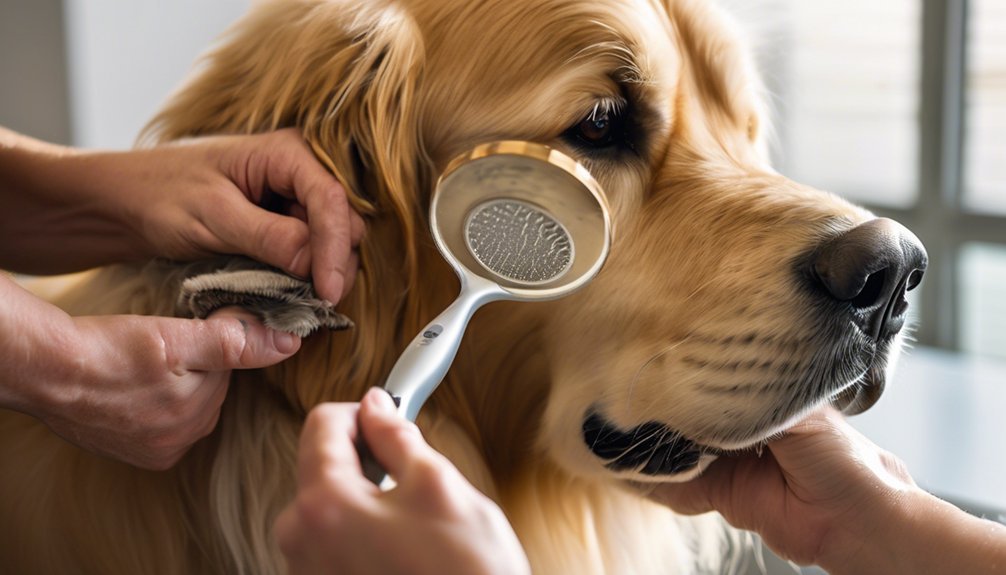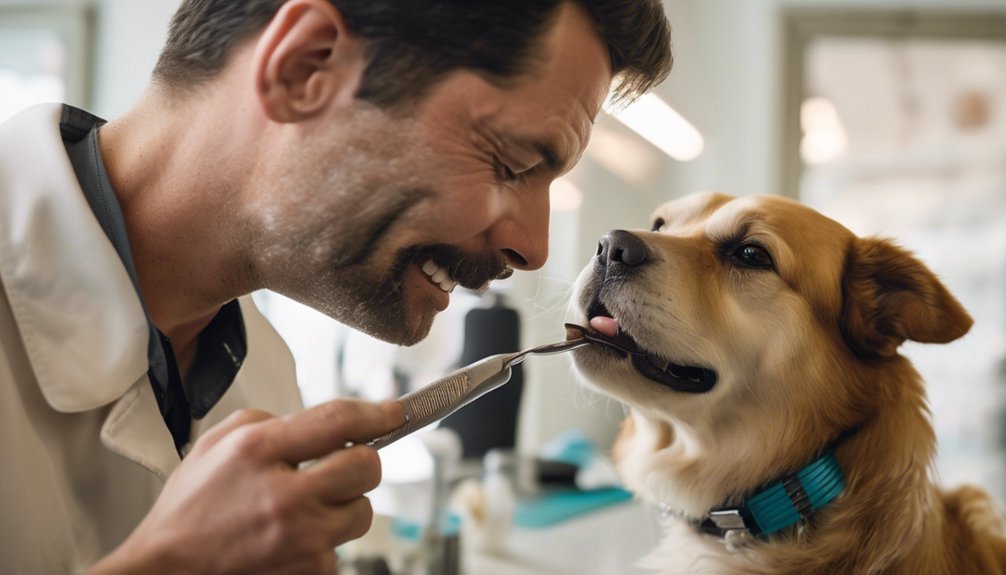
Grooming isn't just about keeping your pet looking good; it's a vital part of monitoring their health. During these sessions, you can spot early signs of skin issues, dental problems, or unusual growths that might otherwise go unnoticed. By paying attention to your pet's condition, you can catch potential health concerns early. But what specific signs should you be vigilant about? Let's explore the key areas to focus on during grooming.
Key Takeaways
- Regular grooming allows for early detection of skin issues, such as irritation, redness, and unusual odors that signal potential infections.
- Inspect your pet's coat for changes in texture, patchy fur, or mats, which may indicate underlying health problems.
- Monitor your pet's weight and body condition during grooming sessions to identify significant fluctuations needing veterinary attention.
- Examine your pet's eyes for discharge, redness, or cloudiness, as these may suggest infections or deteriorating vision.
- Use grooming as a time to bond with your pet, enhancing your awareness of any health changes that may arise.
Understanding the Importance of Grooming for Health

While you might think of grooming as just a cosmetic routine, it plays a crucial role in detecting potential health issues.
Regular grooming offers significant grooming benefits, allowing you to observe subtle changes in your body's health indicators. For instance, while brushing your hair, you might notice unusual hair loss or changes in texture, signaling underlying conditions.
Similarly, inspecting your skin for dryness or irregularities can reveal much more than cosmetic needs. By being attentive during your grooming rituals, you cultivate a deeper connection with your body and can identify potential health concerns early.
This proactive approach not only enhances your appearance but also nurtures your overall well-being, ensuring you stay in tune with your health.
Signs of Skin Conditions to Look For
What signs should you be on the lookout for when it comes to skin conditions? Keep an eye out for skin irritation that may indicate allergy symptoms.
You might notice patchy fur or excessive scratching, which can lead to hair loss. Flaky skin is another red flag, as are hot spots that appear suddenly.
Look for redness and inflammation, as these can signify underlying issues. Additionally, be aware of any scabs or bumps that develop on your pet's skin.
If you detect any unusual odor issues, don't ignore them. These signs can point to infections or other health concerns that require your attention.
Regular checks can make a significant difference in your pet's well-being, so stay vigilant.
How to Examine Your Pet's Coat Effectively

When examining your pet's coat, it's essential to be thorough and attentive to detail. Start by gently running your fingers through their fur, paying close attention to the coat texture. Notice any abnormalities, such as dryness, excessive oiliness, or unusual clumping.
Use grooming tools like a slicker brush or a comb to help reveal hidden issues, such as mats or skin irritations. As you groom, check for parasites or unusual odors that might signal underlying health problems.
Don't forget to inspect the skin beneath the fur; it should appear healthy and free of redness or bumps. Regularly examining your pet's coat not only keeps them looking good but can also help you catch potential health issues early.
Observing Your Pet's Ears for Potential Issues
After checking your pet's coat, it's important to turn your attention to their ears, which can reveal a lot about their overall health.
Look for signs of redness, swelling, or a foul odor, as these may indicate ear infections. If you notice excessive scratching or head shaking, it could suggest the presence of ear mites.
Regular ear checks can help you catch these issues early, preventing discomfort for your furry friend.
Gently clean their ears with a vet-recommended solution, but avoid using cotton swabs, which can push debris deeper.
Identifying Dental Problems During Grooming

While grooming your pet, it's crucial to pay attention to their dental health, as many pets suffer from dental issues that can go unnoticed until they become serious.
Check their gums for redness or swelling, and look for any signs of plaque buildup on their teeth. A healthy mouth should have pink gums and clean teeth. If you notice dark stains or excessive tartar, it's a sign their dental hygiene needs improvement.
Regular brushing at home and dental check-ups with your vet can prevent serious problems down the line. Remember, maintaining good dental health isn't just about fresh breath; it's vital for your pet's overall well-being.
Monitoring Weight and Body Condition
As you focus on your pet's dental health, don't overlook the importance of monitoring their weight and body condition.
Regular grooming sessions provide an excellent opportunity to observe any weight fluctuations that may indicate underlying health issues.
Use body scoring techniques to assess your pet's condition, looking for the right balance between being too thin and overweight.
Pay attention to how easily you can feel their ribs and whether their waist is defined.
If you notice significant changes, consult your veterinarian to discuss potential concerns.
This proactive approach not only helps maintain your pet's overall health but also strengthens the bond you share, ensuring your furry friend stays happy and vibrant for years to come.
Checking for Unusual Growths or Lumps

One crucial aspect of your pet's grooming routine is checking for unusual growths or lumps. As you gently run your hands over their body, pay attention to any areas that feel different.
Note the lump characteristics—size, shape, and texture—since these can provide important clues about your pet's health. Common growth locations include the underbelly, between the legs, and around the neck.
If you discover anything unusual, don't hesitate to consult your veterinarian. Early detection can make a significant difference in treatment options and outcomes.
The Role of Nail Care in Overall Health
Nail care plays a vital role in your pet's overall health and well-being. Regular nail trimming not only keeps your pet comfortable but also helps you spot potential health issues. For instance, nail discoloration can indicate underlying problems, including infections or nutritional deficiencies.
| Nail Care | Health Indicator |
|---|---|
| Regular Nail Trimming | Prevents pain and mobility issues |
| Nail Discoloration | Possible infections or deficiencies |
| Overgrown Nails | Risk of injury or joint problems |
Assessing Your Pet's Eyes and Vision

Regularly assessing your pet's eyes and vision is crucial for their overall health.
By keeping an eye on these aspects, you can ensure your furry friend stays happy and healthy.
Here are three key indicators to watch for:
- Eye Discharge: Check for any unusual discharge, which can signal infections or allergies.
- Vision Clarity: Observe how your pet navigates their environment. Hesitation or bumping into objects may indicate vision problems.
- Eye Appearance: Look for redness, cloudiness, or swelling; these can be signs of serious concerns.
Taking Action: When to Consult a Veterinarian
Noticing changes in your pet's eyes and vision can be alarming, and it's important to act swiftly. If you see signs like squinting, redness, or unusual discharge, don't hesitate to consult your veterinarian. These could be emergency signs indicating underlying issues that need immediate attention.
Remember, taking preventive measures is crucial for your pet's health. Regular check-ups can help catch problems before they escalate. If your pet seems to be in pain or is behaving differently, trust your instincts and seek help.
Your veterinarian can provide the best guidance and treatment options. Always prioritize your pet's well-being; after all, their health relies on your vigilance and care.
Frequently Asked Questions
How Often Should I Groom My Pet for Health Monitoring?
You should groom your pet regularly, ideally once a week. This grooming frequency helps you spot health indicators like skin issues or unusual lumps, ensuring your furry friend stays healthy and happy. Regular check-ins matter!
Can Grooming Stress My Pet During the Examination?
You'd think grooming would be relaxing, right? Instead, it can trigger grooming anxiety in some pets. Watch their behavior closely; signs of stress are crucial for understanding their comfort and ensuring a positive experience during examinations.
What Tools Are Best for Grooming Assessments?
For effective grooming assessments, you'll want to use quality grooming tools like slicker brushes, combs, and clippers. These tools not only help maintain your pet's coat but also allow you to spot potential health issues quickly.
Are There Specific Breeds That Require More Grooming Attention?
Did you know that some breeds require grooming up to five times a week? Understanding breed characteristics helps you determine grooming frequency, ensuring your furry friend stays healthy and comfortable while maintaining their beautiful coat.
How Can I Make Grooming a Positive Experience for My Pet?
To make grooming a positive experience for your pet, incorporate positive reinforcement during grooming routines. Use treats, praise, and gentle handling to build trust, making each session enjoyable and strengthening your bond with your furry companion.
Conclusion
By incorporating regular grooming into your pet care routine, you're not just maintaining their appearance; you're safeguarding their health. Each brush stroke is an opportunity to connect with your furry companion and uncover any hidden concerns. Remember, a small sign could lead to a significant issue, so stay vigilant. After all, your pet relies on you to be their first line of defense. Don't hesitate to reach out to your veterinarian—your pet deserves the best care possible.





